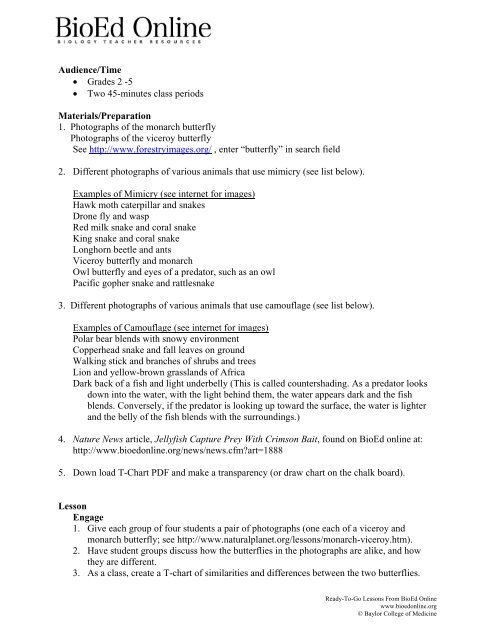Audience/Time• Grades 2 -5• Two 45-minutes class periodsMaterials/Preparation1. Photographs of the monarch butterflyPhotographs of the viceroy butterflySee http://www.forestryimages.org/ , enter “butterfly” in search field2. Different photographs of various animals that use mimicry (see list below).Examples of <strong>Mimicry</strong> (see internet for images)Hawk moth caterpillar <strong>and</strong> snakesDrone fly <strong>and</strong> waspRed milk snake <strong>and</strong> coral snakeKing snake <strong>and</strong> coral snakeLonghorn beetle <strong>and</strong> antsViceroy butterfly <strong>and</strong> monarchOwl butterfly <strong>and</strong> eyes of a predator, such as an owlPacific gopher snake <strong>and</strong> rattlesnake3. Different photographs of various animals that use camouflage (see list below).Examples of <strong>Camouflage</strong> (see internet for images)Polar bear blends with snowy environmentCopperhead snake <strong>and</strong> fall leaves on groundWalking stick <strong>and</strong> branches of shrubs <strong>and</strong> treesLion <strong>and</strong> yellow-brown grassl<strong>and</strong>s of AfricaDark back of a fish <strong>and</strong> light underbelly (This is called countershading. As a predator looksdown into the water, with the light behind them, the water appears dark <strong>and</strong> the fishblends. Conversely, if the predator is looking up toward the surface, the water is lighter<strong>and</strong> the belly of the fish blends with the surroundings.)4. Nature News article, Jellyfish Capture Prey With Crimson Bait, found on BioEd online at:http://www.bioedonline.org/news/news.cfm?art=18885. Down load T-Chart PDF <strong>and</strong> make a transparency (or draw chart on the chalk board).<strong>Lesson</strong>Engage1. Give each group of four students a pair of photographs (one each of a viceroy <strong>and</strong>monarch butterfly; see http://www.naturalplanet.org/lessons/monarch-viceroy.htm).2. Have student groups discuss how the butterflies in the photographs are alike, <strong>and</strong> howthey are different.3. As a class, create a T-chart of similarities <strong>and</strong> differences between the two butterflies.Ready-To-Go <strong>Lesson</strong>s From BioEd Onlinewww.bioedonline.org© Baylor College of Medicine
(Note: A T-chart is a type of graphic organizer to help organize thoughts <strong>and</strong> showrelationships. In this case, it will show how a monarch butterfly <strong>and</strong> viceroy butterfly arealike, <strong>and</strong> how they are different.)4. Discuss the meaning of mimicry. Explain to students that butterflies are often eaten bybirds. The monarch is foul-tasting or poisonous to birds, while the viceroy is notpoisonous or foul-tasting. Ask students, Which butterfly is mimicking the other? Why?Explore1. Give each group of students photographs of animals that mimic another organism inorder to gain some type of advantage, or special help to survive in its environment.2. Ask each group to examine the photographs <strong>and</strong> decide:a) Is the animal mimicking another organism? If so, what organism? What is theadvantage?b) Does the animal possess a structure, coloration, or pattern that mimics anothertype of organism or part of an organism? If so, what is it? Why is it anadvantage to the organism?Explain1. Each group will share their group’s findings about one of the photographs they received.Discuss each one as a class <strong>and</strong> reach consensus on all the organisms in the photographs.2. Read or summarize the Nature News article, Jellyfish Capture Prey With Crimson Bait,found on BioEd Online: http://www.bioedonline.org/news/news.cfm?art=1888. Ask, Isthis article is describing a form of mimicry? (This article describes a jellyfish with atentacle that “mimics” a type of food for deep sea fish. The tentacle is used is to lure thefish close to the jellyfish so that it can capture the fish as its own food.) Discuss thisarticle as a class. Ask if any students can think of similar examples?Elaborate/Extend1. Review the meaning of mimicry with the class, <strong>and</strong> introduce or review the term,camouflage.2. Discuss how camouflage <strong>and</strong> mimicry are different, <strong>and</strong> how they are alike. For example,both camouflage <strong>and</strong> mimicry provide an advantage for an organism, <strong>and</strong> both involvethe organism copying either another organism or part of its environment. The primarydifference is that, with mimicry, an organism copies another organism or part of anorganism, while camouflage involves the copying of some part of the environment.3. Distribute (or have students locate <strong>and</strong> bring to class) pictures of animals that mimicother organisms <strong>and</strong> animals that use camouflage in their environments. Have studentscreate a T-chart showing which animals exhibit mimicry <strong>and</strong> which employ camouflage.4. Ask groups to share the information on their T-charts with the class <strong>and</strong> explain how theydecided which animals to put into each category.Ready-To-Go <strong>Lesson</strong>s From BioEd Onlinewww.bioedonline.org© Baylor College of Medicine




